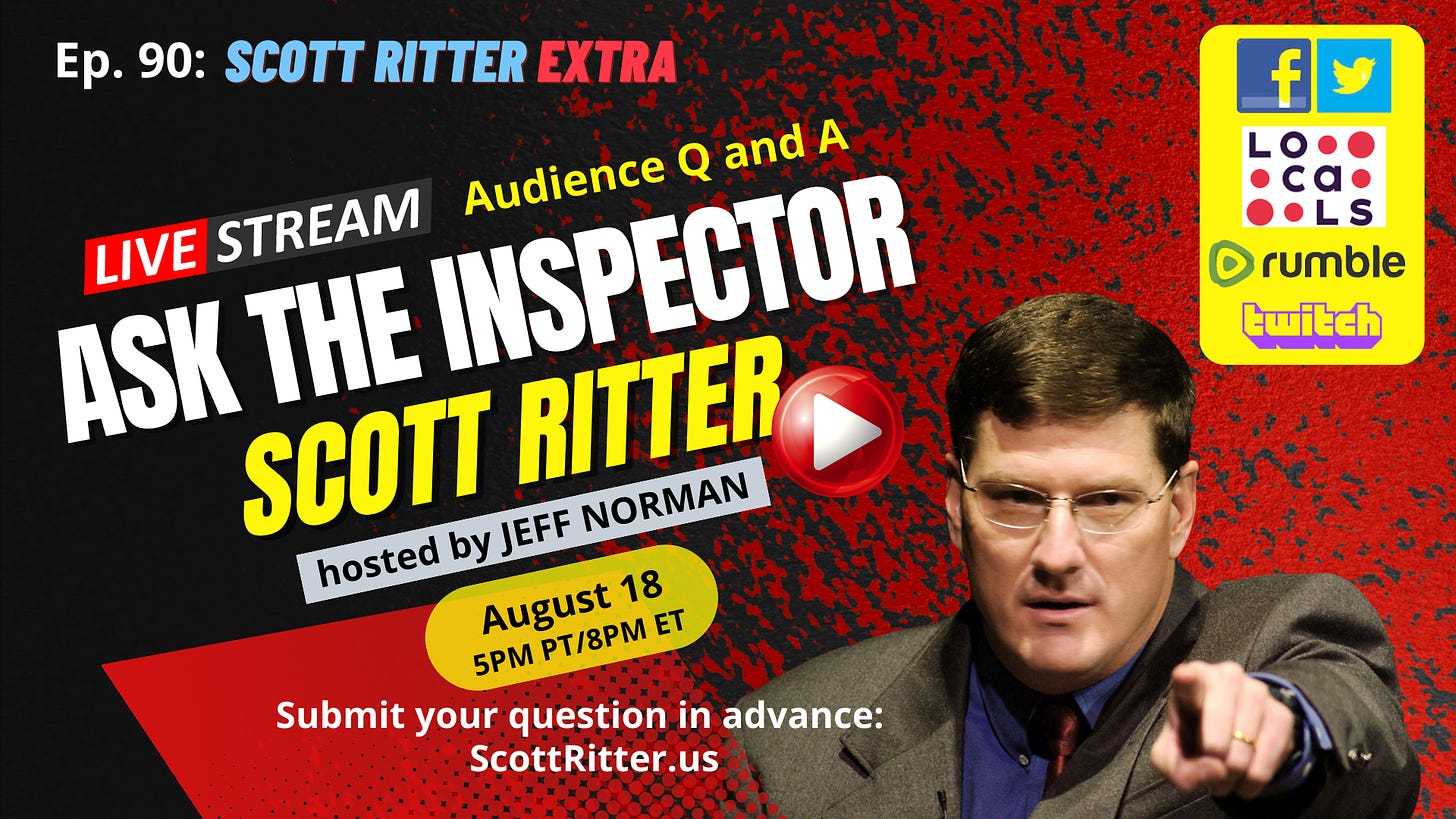YouTube, Censorship, and the American Way of Life. Scott Ritter
A Personal Journey

All Global Research articles can be read in 51 languages by activating the Translate Website button below the author’s name.
To receive Global Research’s Daily Newsletter (selected articles), click here.
Click the share button above to email/forward this article to your friends and colleagues. Follow us on Instagram and Twitter and subscribe to our Telegram Channel. Feel free to repost and share widely Global Research articles.
***
On Friday, August 11, YouTube shut down the US Tour of Duty channel. The reason cited was “violations of our Community Guidelines,” although no specific example was cited. Neither was a warning issued. Simple termination, with prejudice.
There are some, including a certain former US Marine electro-optical repair specialist-turned-geopolitical analyst, who view the YouTube action as a form of karma for my public pronouncements regarding Gonzalo Lira and my assessment regarding his relationship with the Ukrainian intelligence service, or SBU. But life, like geopolitics, is never that simple.
First and foremost, the decision to terminate the US Tour of Duty channel, which hosted both my “Ask the Inspector” podcast and Jeff Norman’s collaboration with Tori Mansfield and Arkady Itkin, “Scenes from the Evolution,” coincided with the termination of a separate YouTube channel, managed by the Russian media organization “Solovyov Live!,” which hosted a separate weekly podcast, “The Scott Ritter Show,” where I interviewed Russian guests about topics of the day. There was no connectivity between Solovyov Live! and US Tour of Duty in terms of content, and as such to have both terminated on the same day for the same reason is more representative of desired effect as opposed to justifiable cause.
Simply put, YouTube wanted me gone.
The journey toward YouTube termination, however, suggests that YouTube had a larger motive than simply silencing an inconvenient voice. If that was the goal, then the US Tour of Duty channel, would have had the plug pulled shortly after the inaugural episode of “Ask the Inspector,” which premiered in July of 2022, and featured former CIA analyst Larry Johnson as a guest. But YouTube allowed the channel to persist for more than a year, eventually garnering some 63,000 subscribers.

Scott Ritter will discuss this article and answer audience questions on Ep. 90 of Ask the Inspector.
YouTube, I discovered, is all about the numbers. Unless one commits copyright violation, or airs something so egregiously outrageous that the content monitors in YouTube’s ironically named “Trust and Safety Division” have no choice but to take action, most YouTube channels go about their business with no interference from the powers that be in San Bruno, California.
But once you cross a specific threshold in terms of subscribers, and/or a designated sustained rate of viewers, YouTube suddenly takes an interest. The reason—money. Simply put, YouTube makes its money by attracting advertisers who are in turn attracted by viewership. To attract content capable of generating the level of views that would be attractive to mainstream advertisers, YouTube has a monetization incentive where channels that generate large numbers of views are rewarded with money. While most YouTube channels which are monetized receive modest renumeration, some YouTube channels are capable of generating tens of thousands of dollars on YouTube-sourced income every week.
Once you reach a certain monetization potential, you will automatically fall under the watchful eyes of the YouTube “Trust and Safety Division,” which is liberally staffed with not-so-liberal former CIA and FBI employees. The reason for this is that, given the YouTube monetization algorithm, a channel that generates x number of views is automatically used as a platform for advertisement insertion by YouTube—this happens whether the content provider wants it or not (it is also an incentive for YouTube subscribers option to pay money for an “ad free” experience). The problem, however, is that these mainstream advertisers do not want their product associated with messaging considered “controversial” by the mainstream, and since the insertion of the ads is automatic, the YouTube censors must come up with a way to either limit the number of views a channel is recognized as having generated, or by shutting down the channel altogether. YouTube, however, is a business, and if it automatically banned channels which had genuine growth potential (and, as such, advertisement revenue generation capability), then it would not be the multi-billion-dollar corporation it is today.
What follows is an analysis of what I believe is a representative model of how YouTube uses the allure of monetization to compel YouTube content providers to comply with the need to control content in a manner which keeps the corporate advertisers who make YouTube possible happy. First, a YouTube channel which is exhibiting growth potential finds itself being “toyed” with by the boys and girls at the “Trust and Safety Division.” Let’s say, for instance, one was to upload a two-part documentary about Ukrainian President Zelensky (we’ll call it “Agent Zelensky”) which garnered a quarter-million or more views. The trusty censors at the “Trust and Safety Division” will arbitrarily intervene to “age restrict” the video, which limits drastically the number of views (and, by extension, the potential for monetization.)
The channel owner can, of course, submit an appeal, which, based upon experience, is often granted. But the lesson learned here isn’t that one can win an appeal, but rather that one should avoid getting in a position where one needs to appeal. Self-censorship, it seems, is one of the main ways YouTube controls content.
If a channel is deemed to have serious growth potential (remember—more views equals more mainstream advertisement dollars!), then the channel owner will be contacted by “agents” who make use of “talent scouts” who monitor flagged channels for growth potential. If a channel passes muster, then the agent will provide the channel with an opportunity to earn “easy” income, usually by reading a short advertisement blurb at the start of their podcast. While the amount of money generated in this manner is modest, it is—literally—“easy” money, allowing the recipient to be susceptible to notions of even greater income generation, notions the agent reinforces when discussing the income growth potential of a YouTube channel with the owner.
The money is the drug that blinds most YouTubers into ignoring the process that is actually taking place. By leading the channel owner horse to water, the agent fully expects the money-thirsty channel owner to drink, and drink again. It is at this juncture that the “Trust and Safety Division” team interjects again, usually to demonetize the YouTube channel in question. This is a classic baited trap—lure someone in with the promise and realized potential of income generation, promote the idea of unrealized wealth, and then take it all away, leaving the channel owner frustrated and willing to do what it takes to get back on the money train.
And here is where the issue of self-censorship comes in with full force—to get back on the train, the channel owner will have to undergo changes to his or her channel, both in terms of how content is delivered (remember—more viewers!) and what content is allowed to be put on the channel. In our case, the agent listed 10 prohibited subjects, one of which was the Ukrainian conflict.
We balked, they banned.
Putting content on YouTube takes work—a lot of work, if you’re going to do it right. And since money unfortunately does not grow on trees, viable mechanisms of monetization are necessary if the YouTube content provider is going to be in a position to stream quality programming.
But the YouTube model is the antithesis of free speech.
It is controlled speech.
But worse, it is controlled speech where the mechanism of control is disguised through the vehicle of self-censorship, thereby creating the illusion of free speech.
The bottom line is that a successful YouTube channel must adhere to the four corners of content control defined by the “Trust and Safety Division.” This is not, on its own volition, a violation of protected speech, since YouTube is a private company operating outside the protections of the First Amendment.
The problem comes when YouTube, like Twitter before it, allows its internal censors to be influenced by government actors. Twitter has already been shown to have been influenced by FBI agents who, at the behest of the Ukrainian intelligence service, asked that certain Twitter accounts be shut down. Behavioral science suggests that patterns repeat, and as such there is every reason to suspect that YouTube, and other US-based social media platforms, are subjected to similar pressure to censor content by US government personnel and agencies.
While legal challenges are possible (the current exposure of Twitter stands as an example), it takes time and money most YouTube content providers do not have.
There is an alternative course of action, however—Rumble. That’s what Jeff, me, and the Solovyov Live! team have chosen as our platform for continuing both “The Scott Ritter Show” and “Ask the Inspector” (and “Scenes from the Evolution” as well). While the pathway to monetization potential on Rumble is not as clear as it is with YouTube, one thing is for certain—Rumble is, for the moment at least, a free-speech platform. Jeff and I will be free to stream any content so long as it conforms with the law.
This, more than anything, including potential monetization, is what is important to us. “Ask the Inspector” was deemed by a talent scout to be a “million dollar” property. The problem was, to get those million dollars, Jeff and I would have to alter the content of the property to the point that it would be unrecognizable from the original.
We refuse to do this because free speech isn’t for sale.
It is the most American thing we can think of doing, placing principle over profit.
We hope everyone who reads this will join us on Rumble as we take “The Scott Ritter Show” and “Ask the Inspector” (and “Scenes from the Evolution”) into a successful second season, and beyond. We will also be creating special content for paid subscribers on Locals, nothing there is behind a paywall yet.
*
Note to readers: Please click the share button above. Follow us on Instagram and Twitter and subscribe to our Telegram Channel. Feel free to repost and share widely Global Research articles.

